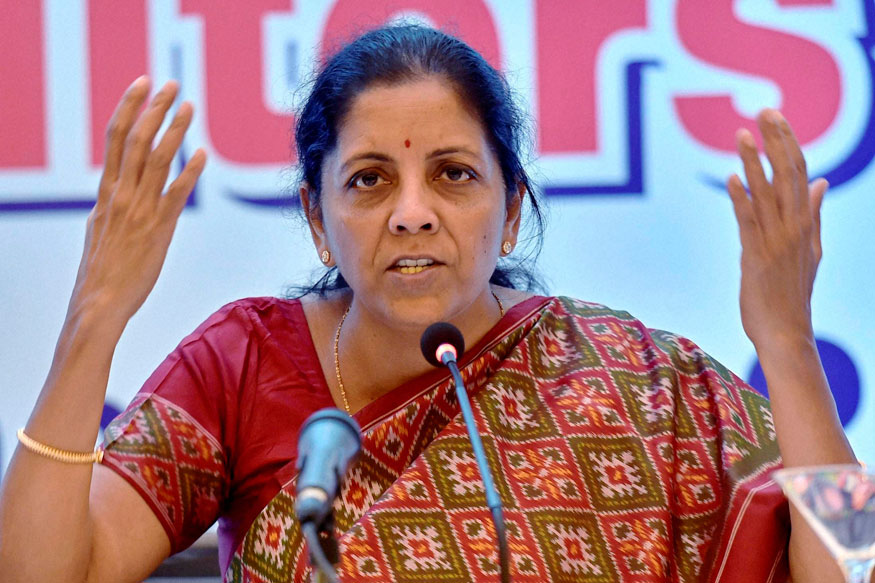by Haseeb A Drabu
The first budget for the Union Territory of J&K presented by Finance Minister, Nirmala Sitharaman reflects the existential crisis that Jammu and Kashmir is currently in. Constitutionally, J&K is a Union Territory with the legislature. The reality on the ground is that there is no legislature. So, for now, it is a Union Territory without legislature.

The unprecedented downgrading from a state to a Union Territory has, of course, major implications on J&K’s fiscal federal relations with the Union government. Preoccupied as everyone has been with the political fallout, the financial consequences have not been even pointed out yet let alone discussed and contested.
The Budget presented to the Parliament on the 17th of March, 2020 is not a Budget of J&K, it is budget for J&K. The budget is not only blasphemous to the tenets of fiscal federalism; it violates basic budgetary arithmetic and analytics.
Sample this. On page 5 of the Budget at a Glance, Table 3, “Total Grants from Centre” includes, Rs 15,200 crore as “Share in Central Taxes”! Anyone with a nodding knowledge of centre-state fiscal relations will know that the share of centre taxes is a constitutional right under Article 270 and not a grant. Similarly, on page 9, Table 7, “Statutory Flows from Centre” includes PM Reconstruction plan, PMIP, CSS and grant for allowances. All these are not statutory but discretionary grants.
There is more to this than the wrong classification. J&K as a Union Territory is not entitled to a share in the central taxes. In fact, no resource transfer after August 5th 2019 from the centre to J&K is statutory.
The Constitution (Eightieth Amendment) Act, 2000 amended Articles 269, 270 and 272 to specifically exclude Union Territories from getting a share in the net proceeds of Centre’s indirect taxes. Far from sharing, this Act includes the net proceeds of indirect taxes from Union Territories as a part of the consolidated fund of India. As a result, in addition to the administrative control, in fiscal matters, Union Territories are subsumed into the Centre. The financial allocations and requirements of Union Territories are clubbed along with the demand for grants of the Home Ministry.
So at is stands now, the Constitution doesn’t allow the Centre to share its taxes with J&K. The rights of J&K have now become the requirements of centre! As such, the first major implication of the August 5 actions is that the devolution, which was the statutory right of J&K, is now discretion of the Centre. It is no longer an entitlement.
In the Union budget speech, the Finance Minister announced that Rs 30,757 crore has been “provided to the Union Territory of Jammu and Kashmir for the Financial Year 2020-21”. What was earlier the share of the J&K in central taxes is now, technically speaking, a budgetary provision in the Union Budget, a part of Home Ministries demands.
To be fair, she has topped it up marginally. The share of J&K as a state was 0.85 per cent of the net tax revenues of the Centre in lieu of 1 per cent has been allocated. As a state, J&K (including Ladakh) would have got around Rs 31,200 crore. Now the Union Territory of J&K and the Union Territory of Ladakh now get Rs 36,715 crore; an additional amount of Rs 5,500 crore. A rough and ready way to look at it is that centre has absorbed the additionality arising out of making Ladakh a Union Territory.
In view of this, the major faux pas of providing “share of taxes” for J&K in a budget document presented to the Parliament is unprecedented. It is making a mockery of the entire system of fiscal transfers.
Such conceptual confusion, presentational ineptitude and gross misclassifications not only mar the integrity of the budget document but also have serious legislative and administrative implications. If these monies or resource transfers are indeed statutory or entitled, then the J&K Budget runs contrary to Jammu and Kashmir the Reorganisation Act, 2019 and is in violation of the Constitution of India as amended on August 5th, 2019.
As regards the budgetary arithmetic, at first sight, the revenue budget looks realistic; at least as far as the estimated own revenues, tax and non-tax, are concerned. In 2020-21, the own revenues are estimated to be a decline from Rs 18,998 crore to Rs 17,306 crore 2019-20. That there should be no increase in revenues despite an estimated to SDP growth of 11 per cent is curious.
But a deeper examination reveals that over and above the own tax revenues of Rs 13,241, the budget has estimated Rs 4,000 crore as additional resource mobilisation. This is an absurd number, which must surely be a first in the fiscal history of J&K! This is without a doubt a piece of fiction written by somebody who has a penchant for writing horror stories.
What it means is that J&K will add one-third of its existing revenues to its kitty in the course of one year! Even the cumulative ARM of last decade or more would not add up to Rs 4,000 crore. Mind you, the ARM is not only over and above the normal buoyancy of revenues, but it also comes at the back of Rs 1,000 crore ARM that is planned from October 2019 to March 2020. With two days left for the financial year, there is yet no ARM measures announced by the J&K administration!
Given the estimated growth of 11 per cent growth in SDP, the elasticity of ARM is estimated to be 2.75. The latest estimate of tax elasticity of indirect taxes in India is 0.90! This is better than any economy anywhere in the world. This defies all logic.
Apart from these magnitudes, this kind of taxation policy which prefers new tax rates and incidences defies all tenets and wisdom of public finance even in a steady-state economy not to talk of an economy in the throes of a crisis.
There is not a single resource mobilisation measure that has been announced in the Budget. Nor has any break-up of the Rs 4,000 crore ARM provided. Theoretically, there are only three ways in which ARM can happen; news taxes, a change in the rate and base of existing taxes or hiking the user charges. The question is what new taxes is the UT administration going to levy? More importantly, what taxes can the UT government levy? What rates can they change? Incidentally, with the abolition of the toll post at Lakhanpur, an oft-exploited source for ARM in the past has also been given up recently.
On the expenditure side, the budget is delusionary. It bears no relation to the ground reality. The Budget estimates that Rs 14,885 crore will be spent on capital account between October 2019 and March 31st, 2020. Setting aside debt repayment of Rs 1,000 crore, how will the remaining Rs 14,000 crore be spent?

It is well-known from August 2019 to January 2019, the state, in particular the valley, was under a complete lockdown. There was no developmental work taking place. Realistically speaking, this amounts to spending Rs 5,000 crore per month which is about 165 crore on every working day! The system doesn’t have the absorptive capacity for this. Even if did, the pandemic will make it absolutely impossible to do any capital works. The March madness at treasuries must have taken over by now!
To sum up, the first budget of the UT of J&K is conceptually flawed, technically amateurish and operationally impractical. It needs to be withdrawn as it misleads the House and is in breach of parliamentary privilege.
Tailpiece
If the UT administration of J&K is serious about meeting its budgeted ARM of Rs 4,000 crore, they may want to take a leaf from the fiscal history of Kashmir. Pandit Kalhana records in the Rajatarangni that King Harsha who ruled Kashmir from 1089 – 1111 CE, levied a “special tax on night soil”. To make sure that it was collected a “prefect of night soil” was duly appointed. This will surely kill two birds with one stone; revenue target will be met and employment will be generated!
(Author, an economist, is the former finance minister of Jammu and Kashmir state. The critique appeared first in Greater Kashmir.)















